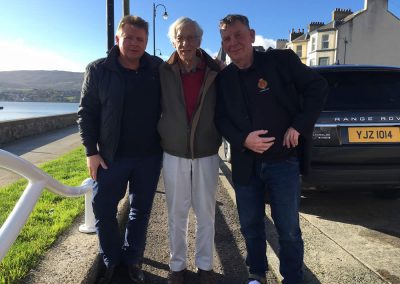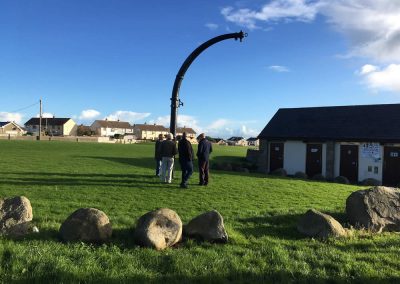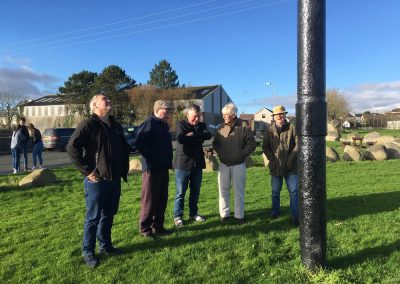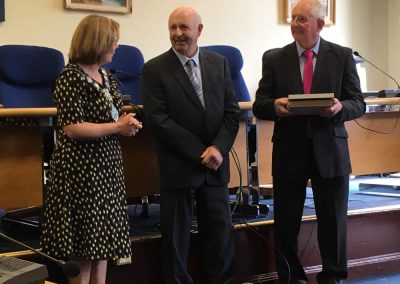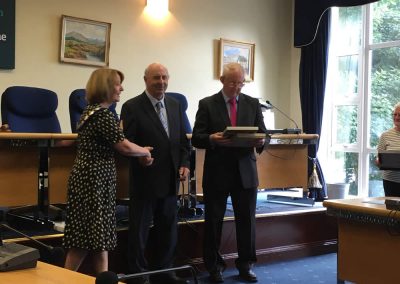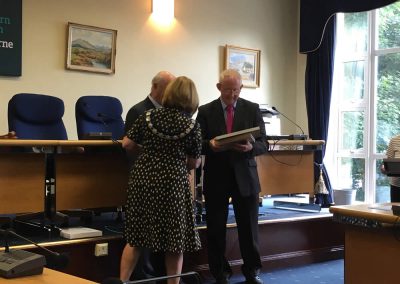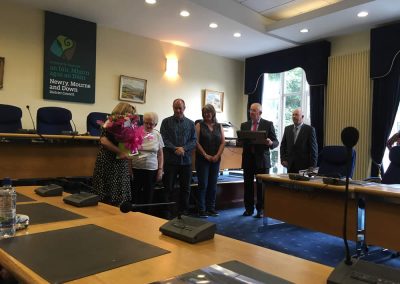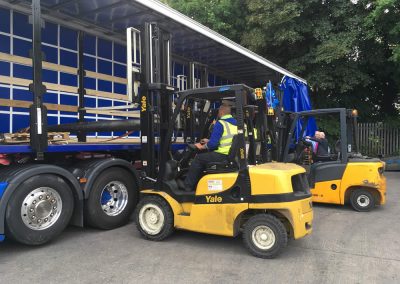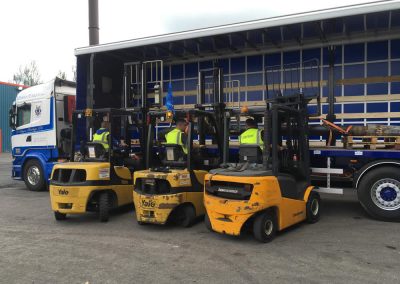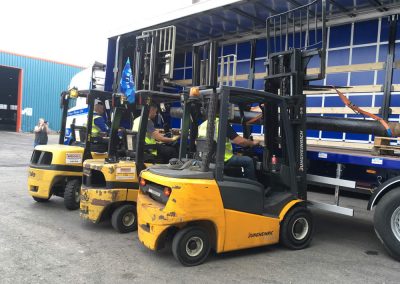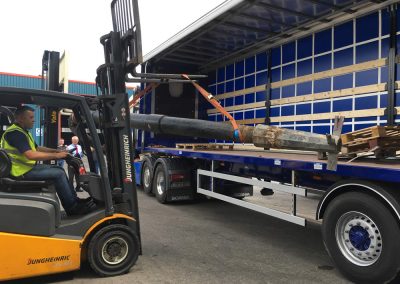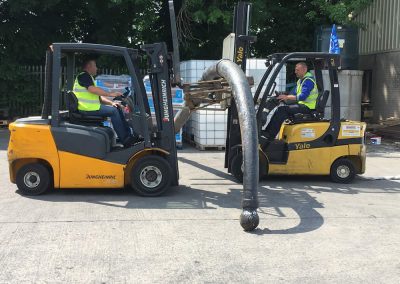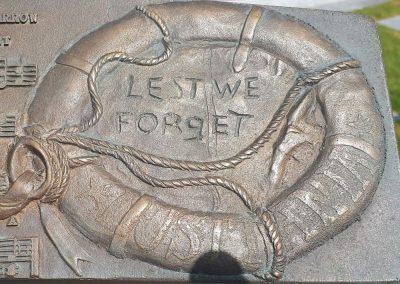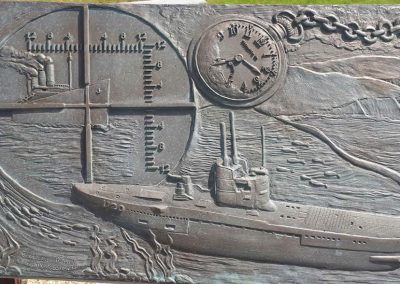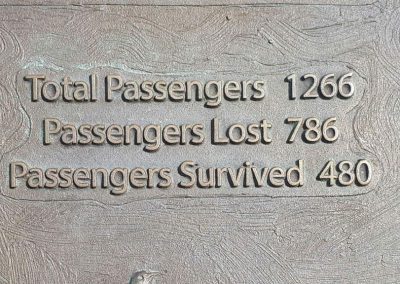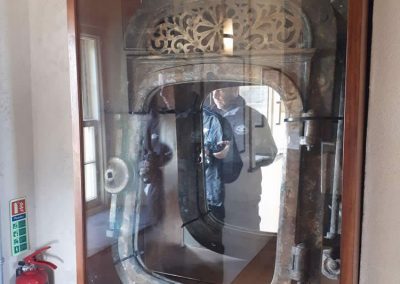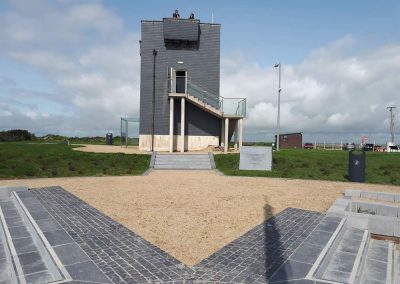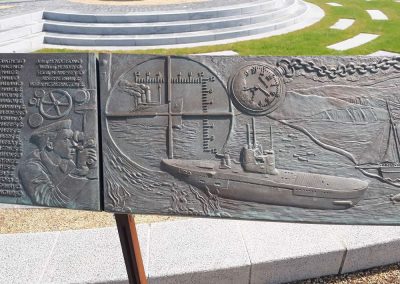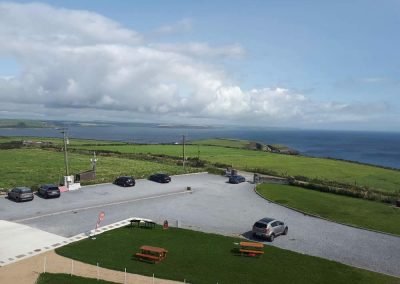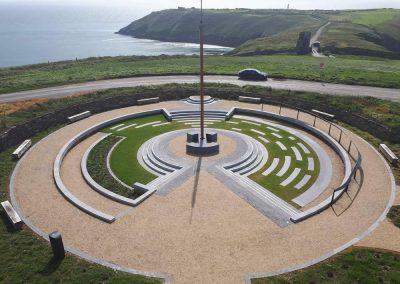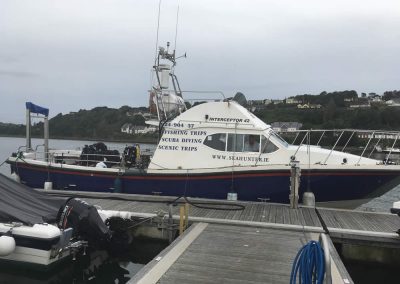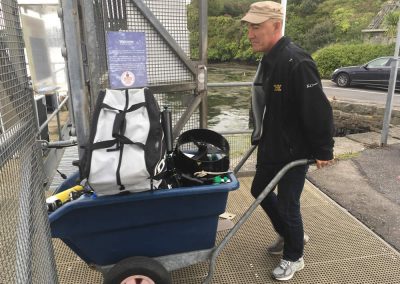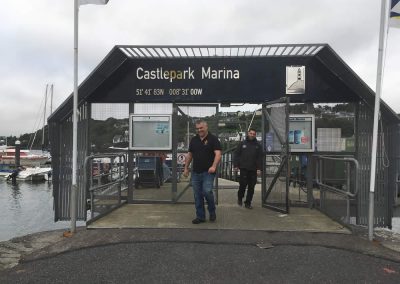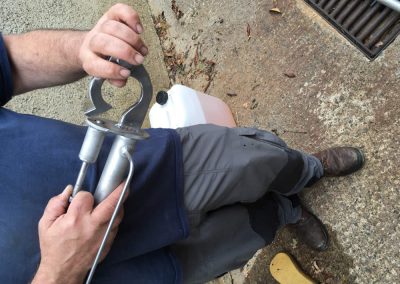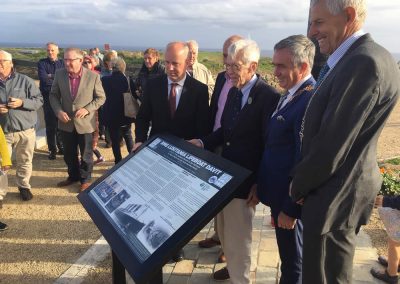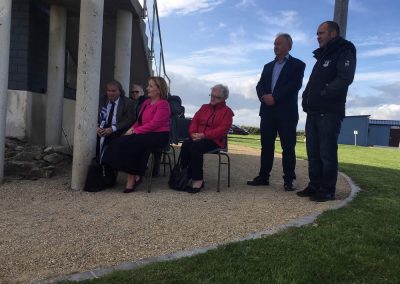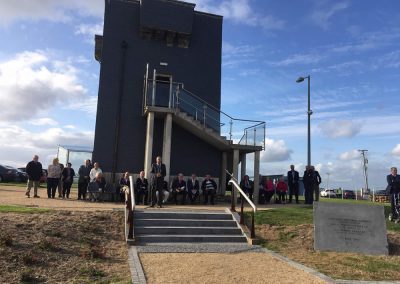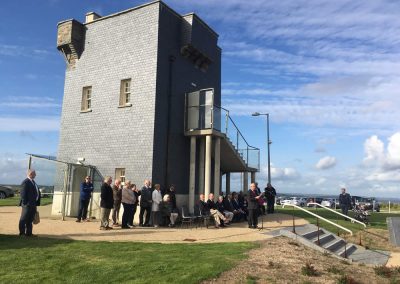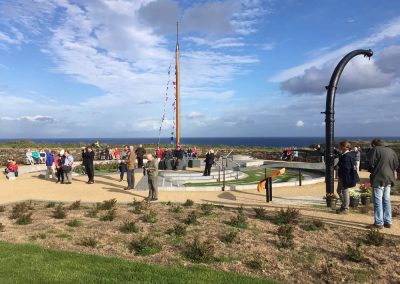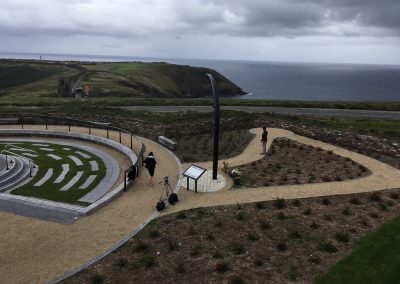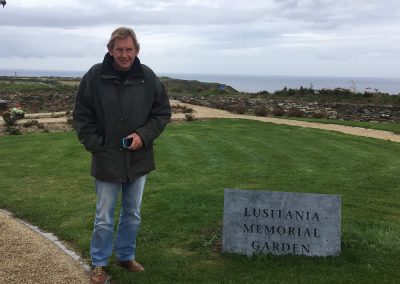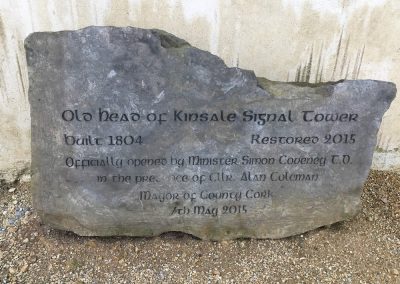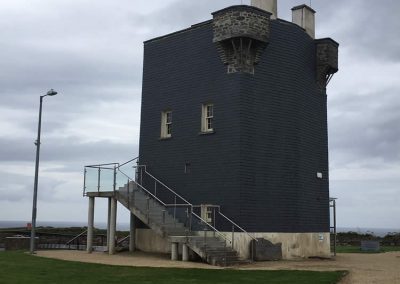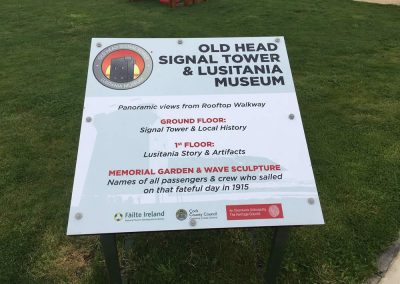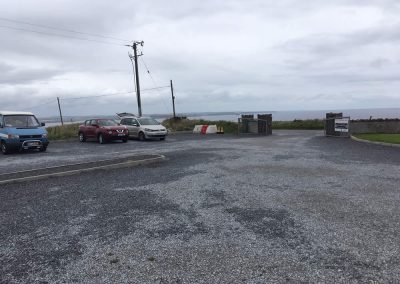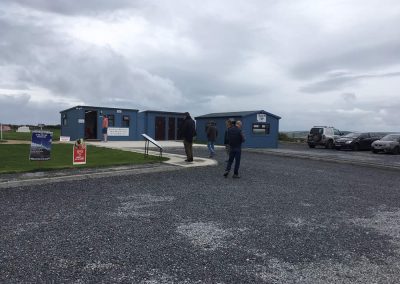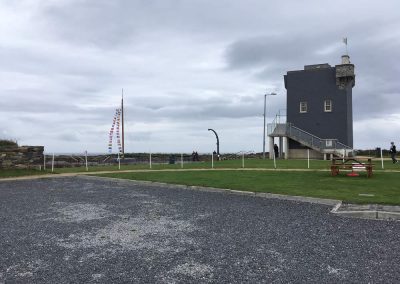Beginning with a ‘cap in hand’ request by our team to the then owner of the Lusitania wreck for permission to dive, an extraordinary tale began that has led to the wreck being transferred to the ownership of The Lusitania Museum in Kinsale on 7th May 2019 …. 104 years to the day from the sinking of the Lusitania.
An email that sowed the seeds for an adventure that was almost as interesting as any visit to the Lusitania!
(Please note that sadly Mr Gregg Bemis has passed away since the original publishing of this article.)
Unknown to us at the time, one of the largest pieces of the Lusitania ever to be recovered was located in Annalong, Co. Down, Northern Ireland since 1963 , for a period of 55 years.
In order to carry out a dive on the Lusitania, the first thing that was required was the permission from the Owner. The owner was a remarkable individual named, F G. Bemis. Mr Bemis lived in Santa Fe, New Mexico. USA.
 It has to be mentioned at this stage that without the permission from Gregg Bemis to dive the Lusitania, which was only the first step in a long saga, none of what you will read below would have happened. Gregg Bemis’s quest for the truth relating to the sinking of the Lusitania began over half a century ago, millions of dollars in research, expeditions and several court cases and he’s as passionate today as he was back in 1968, when he became an owner.
It has to be mentioned at this stage that without the permission from Gregg Bemis to dive the Lusitania, which was only the first step in a long saga, none of what you will read below would have happened. Gregg Bemis’s quest for the truth relating to the sinking of the Lusitania began over half a century ago, millions of dollars in research, expeditions and several court cases and he’s as passionate today as he was back in 1968, when he became an owner.
https://bookhaven.stanford.edu/tag/gregg-bemis/
Half a century is not a long time if you say it quickly, but if you stop for a minute and just try to imagine the drive that it takes to pursue something for over fifty years, it’s an insight to the personality of Gregg Bemis. His focused determination is unparalleled. His passion is infectious. His search for the truth relating to the sinking is limitless.
His other passion, which knows no bounds, is to bring the amazing artefacts from the Lusitania to the Lusitania Museum in Old Head Kinsale.
It is within the care of the Lusitania Museum where the artefacts could well be painfully restored to their former glory and revealed to this generation and future generations, not just from Ireland but from all over the globe; maritime artefacts, the likes of which will never be seen again from an Ocean Liner, which can be mentioned in the same breath as the Titanic.
Unfortunately this is a race against time as each year the Lusitania deteriorates more and more and soon all will be lost forever. At the minute, the clock is ticking and it’s now that we have the chance!
Once you receive the necessary permission from the owner and the Government, the next step is assembling a Dive Team that is capable of carrying out the project works safely and without any harm to themselves or the wreck. It needs to be borne in mind that the Lusitania is Ireland’s largest monument and also Ireland’s worst maritime disaster. The wreck lies in a depth of twice or three times the recreational diving limit, depending on what dive agency is advising the recreational dive limit. The purpose of dives to the wreck is to ascertain the current state of the wreck.
There are also other mysteries relating to sinking of The Lusitania, the main mystery being to know if the ship was actually war materials and high explosives, which since the sinking, the British Government has always firmly denied repeatedly, to this day.
If The Lusitania had indeed been carrying explosive materials, this could well have been the reason for the second explosion and a major contributing factor to one of the largest ships of its day, sinking in just eighteen minutes. It is a well-documented fact that prior to the Lusitania sinking, there were two explosions. There was only one torpedo fired by U Boat 20. Hence if there was only one, what was the cause of the second explosion?
The answers to so many unexplained questions lie at a depth of 90 metres, 11.5 miles out from the Old Head of Kinsale in County Cork. As with so many things, time covers up the answers and presently we have the time, however this will not be the case much longer.
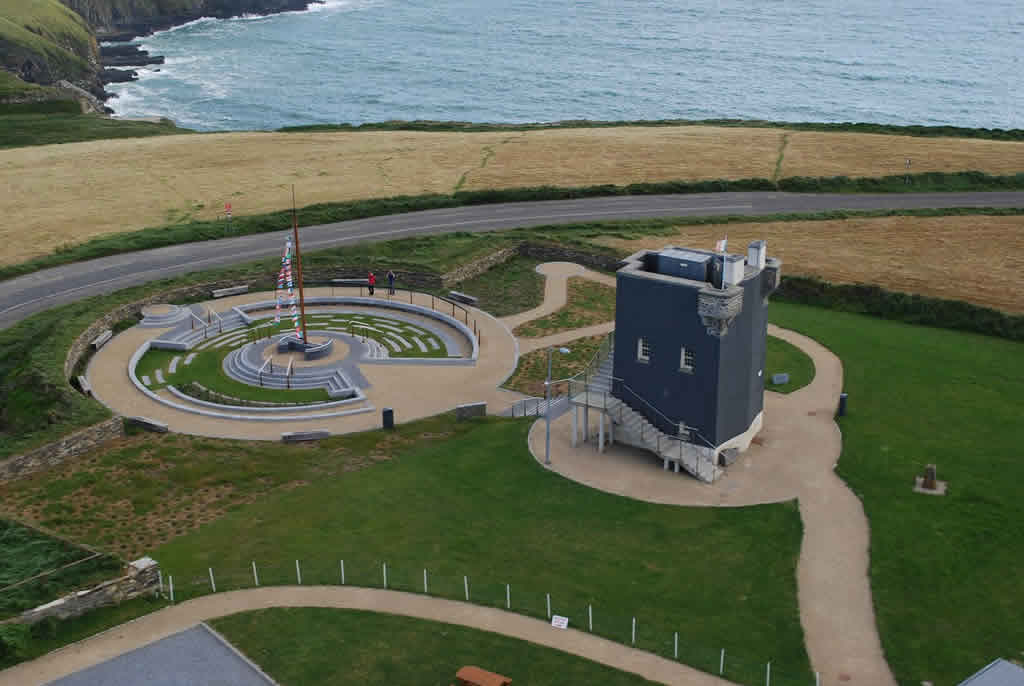
The Old Head Museum at Kinsale
Upon our initial contact with Gregg Bemis, we were informed that for a number of years, the Lusitania Museum in Kinsale had made written requests on several occasions to Newry & Mourne District Council asking that the Lusitania Davit, (one of two arms that suspends a lifeboat) be relocated to the Lusitania Museum in Kinsale from it’s then present location of over 30 years.
That present location was, rather ignominiously, outside public toilets in a park in Annalong.
It was felt by the Lusitania Museum, that its relocation to their site would be a more fitting location, where the artefact could easily be found, looked at and appreciated by visitors to the museum centre.
At that time, all previous requests to Newry & Mourne Council to relocate the artefact had been in vain.
When tasked with such a job, in order to see if we could do something to persuade the Council to meet the request for relocation, there was only one place to begin and that was …. at the beginning.
Gerry Doyle and ‘Croidte án Duin’
In this instance the embryonic route in seeking to get the Lusitania Davit relocated would lie with the owner of the fishing vessel that accidentally hauled the artefact on board. The vessels name was “Croidte an Duin” and the skipper was an individual called Gerry Doyle. Gerry and his family lived in Kilkeel and his fishing vessel was based in Annalong, Co. Down.
Armed with this information Gerry Brown and Peter McCamley headed off in search of Gerry Doyle. It was either fortunate or fate that Gerry Brown had already known members of the Doyle Family. Perhaps it was fate or just a fact that in Ireland if you don’t know someone you will know someone who does know them! At that time, Gerry Doyle had just completed a book about his life relating to some sixty years fishing around Ireland and even further afield. Gerry Brown had been asked by Gerry Doyle to proof read a copy of the book and a meeting was scheduled.
Upon meeting with Gerry Doyle, a story of immense interest unfolded as it was explained that during a fishing trip to Kinsale and whilst fishing near the wreck of the Lusitania on “Croidte an Duin”, when pulling in their nets it soon became apparent that it was possible that they had accidentally caught a large piece of The Lusitania wreckage in their nets. Experienced boat skippers like Gerry Doyle knew not to trawl directly over the wreck or the boats were likely to get the nets snagged. The number of nets which encompass the wreck are evidence of the cost to fishermen of trawling over this wreck in the past. It is likely that another boat had pulled the davit clear of the wreck and it was later caught by Gerry Doyle’s nets
Within minutes of snagging the davit their worst fears were realized by the fact that a large piece of steel in the shape of “an arm” lay across the deck of the fishing boat. The arm weighed approximately five tonnes.
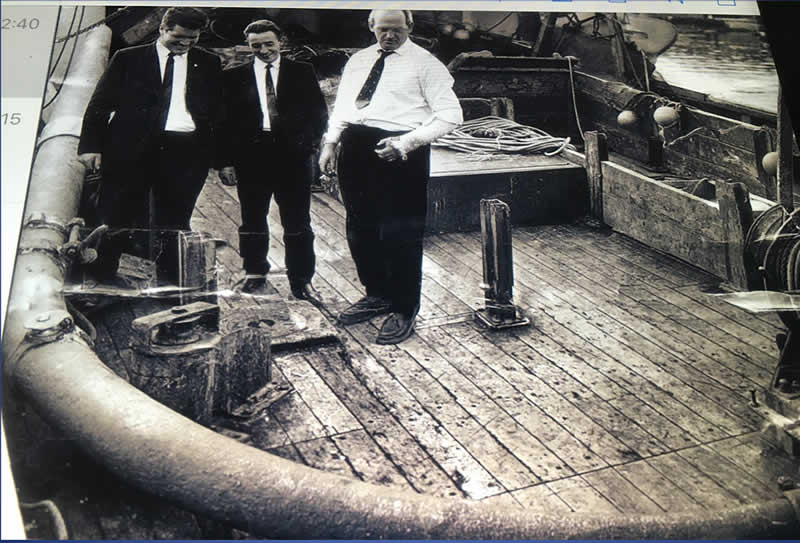
Gerry Doyle and Michael-OHare on the Croidte an Duin 1966
Josie Doyle, Gerry Doyle’s wife, hailed from Clare and upon Gerry Brown’s arrival at the Doyle home she had the kettle on and tea, home baked bread and scones with homemade blackberry jam followed shortly. Josie talked at length about Gerry and his long fishing trips away from home. She talked of the long, fearful absences whilst her husband was at sea. It was understandable that her husband’s safety whilst as sea was always a worry on her mind. Gerry Doyle advised that no boat went the distance or out in the conditions that “Croidte an Duin” ventured out in. The early 60’s were hard times in the UK and it was worse in Northern Ireland.. ” Fishing was always a hard game and not for the faint hearted” Gerry Doyle advised.
Upon making enquiries after arriving back to the closest land mass which was Kinsale with the Lusitania Davit on board his vessel, Gerry Doyle was informed that it would be a costly exercise hiring a crane from Cork City to come to Kinsale harbour to lift the Lusitania Davit off the deck of the Croidte an Duin. Hearing this news it was decided that simply on a fiscal basis it would be better to sail the Lusitania Davit home to Kilkeel where a harbour crane would lift it off Croidte an Duin’s deck.
Gerry Doyle went on to advise that the Lusitania Davit lay at the harbour for years when, in the mid 70’s, a dentist friend asked Gerry if he would mind giving the Lusitania Davit to him as he was eager to install it at his house for to act as a children’s swing. Many years passed and the dentist’s children became adults, without the davit going towards the purpose that it was intended for.
Sometime in the late 1980’s a Newry Council member who was a friend of the dentist and who was aware of the history of the Lusitania Davit requested if it would be possible if the artefact could be donated/loaned to the area and erected at the Park in Annalong. This was the turn of events that took the Lusitania Davit to be erected, outside the public toilets, at a park in Annalong.
The stories that Gerry Doyle revealed about his life that winters evening over many hours with Gerry Brown & Peter McCamley were full of intrigue and both visitors were spell bound by this man of the sea and his seafaring adventures. As the time was now approaching 11pm and the conversation was drawing to a close, Peter McCamley asked Gerry Doyle how he felt about the Lusitania Davit relocation? Gerry looked directly at Peter and replied “ It’s not taking a bit of hurt where it is!”
Peter looked at Gerry and at that moment, it was totally apparent that the whole idea of the Lusitania Davit relocation was dead. We had just fallen at the first hurdle! If this had been a horse that had fallen, well, it would be time to put it out of its misery.
There was a few seconds silence, which seemed like an eternity, and then Josie looked towards her husband and said a few words. “Gerry, I think it should go home!” Gerry Doyle looked into the eyes of his wife and then his eyes moved towards Gerry Brown and Peter “Well, if its home you want it to go, by God home it will go! What do I have to do to get this moving?”
Driving back to Newry that evening, Gerry Brown and Peter were content in the fact that within the past three or four hours, they had now doubled the size of “Team Lusitania Davit”. All that had to done now was to speak to the thirty plus local politicians who represented both sides of the political divide within the Newry & Mourne area. We were all too aware that it was these same political parties, who had deemed it fit for the Lusitania Davit to stay in its present location in Annalong.
That night, immediately upon arrival home from the Doyle family home, Gregg Bemis was contacted and was made aware that there was now four people on board Team Lusitania Davit and he was advised to expect an email from the latest recruits, Gerry and Josie Doyle.
At this stage, due to our interest as divers, we were all too aware of the Lusitania’s history. Unfortunately not everyone in the local area where the Lusitania Davit was located was aware of the Lusitania history. Nor were they aware of the conspiracy theories, and the fact that at the time that the Lusitania sank, Britain was losing the First World War. Some say it was just a coincidence that the Lusitania was in the wrong place at the wrong time when she was sunk by a German U Boat. Was it a coincidence or was it an orchestrated manoeuvre? The outcome of the Lusitania sinking with 128 Americans on board, out of a total death toll of 1201, sowed the seeds that would help bring America into WW1 on the side of the British.
It is also now a fact that Room 40 in Whitehall, was intercepting messages between the German High Command and its U Boats, so was it not impossible that The Lusitania could be steered by The British into the jaws of a German submarine. Room 40, would later become the building blocks that would form Bletchley Park and MI5.
We believed that most people in Newry would not be aware of the role that the sinking of the Lusitania played in world history. We felt that in order to move the whole project forward we would need the support of the local community on board. The local community being the people, who resided in the community of Newry & Mourne, which would have a catchment population of around 100,000 people. This population was represented by the 32 Councilors from every section within the community.
A plan was hatched and we spoke to Gregg and advised that we really needed to awaken the interest in the Lusitania and the Lusitania Davit, so it was agreed that he would make the trip to Newry from Santa Fe, New Mexico and with local media involved, his arrival in Newry would hopefully awaken local interest. The local Maritime Association needed to be involved as it had a great interest and had revived a lot of local maritime history and brought to light events and people ,who had played a part in that history It would also prove a great opportunity to meet with Gerry and Josie Doyle. With the assistance of Ryan Sands, a journalist from The Newry Reporter, an article in in the local paper soon advised all about the existence of The Lusitania Davit and the history relating to it.
Plans were made and for the following weeks, transatlantic relations between Gerry Doyle and Gregg Bemis grew as both laid plans for their potential meeting in November when Gregg was to come to Newry and to Annalong and for his first time see where the artefact was sited. He was very much looking forward to meeting Gerry Doyle and his family.
Sadly only weeks before the meeting, Gerry Doyle passed away.
Shortly before he died Gerry signed a document which requested that The Lusitania Davit be returned to Kinsale. Michael O’Hare helped Gerry with his letter. Shortly after writing the letter, Gerry passed away. As we now look back from where we were at that time, it is simply a fact that Gerry’s letter written by Michael O’Hare was the cornerstone foundation that tugged at the heart strings of all the politicians and the community and caused complete u turn in what people thought about where the Lusitania Davit should be.
0n 4th Nov 2016 Gregg Bemis was collected at Dublin Airport and made his way to Newry where later on that evening we all had dinner at The Canal Court Hotel.
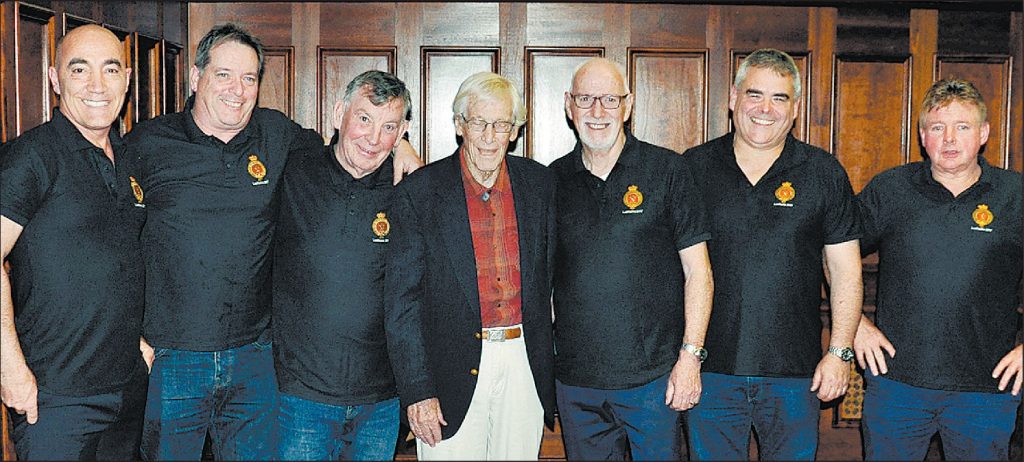
Gregg Bemis and Project 17 Team at the Canal Court Hotel Newry
The local divers who hoped to dive this great wreck Gerry Brown, Jimmy Lyons, David Hankin, Rez Soheil, Frank McDermott and Peter McCamley and their wives met Gregg. Also present were James McArevey and Michael O’Hare and other members of The Newry Maritime Association. The following morning at 8.30 we all met for breakfast. It had been decided that we would take Gregg to see the location of the Lusitania davit and it’s very delapated condition and call and meet the Doyle family!
During Gregg’s time with us in Newry, Gregg met with all the members of The Newry & Mourne Maritime Society. This was an important step because one member of this association Michael O’Hare was actually with Gerry Doyle on that day in 1963 on his boat when he accidentally raised he Lusitania Davit from the seabed. When we spoke to Michael, he vividly remembered the event, like it was yesterday. He like other members of the association felt that The Lusitania Davit should be returned home, to the Kinsale museum. The Maritime Association got to work to see what they could do help get the Davit relocated.
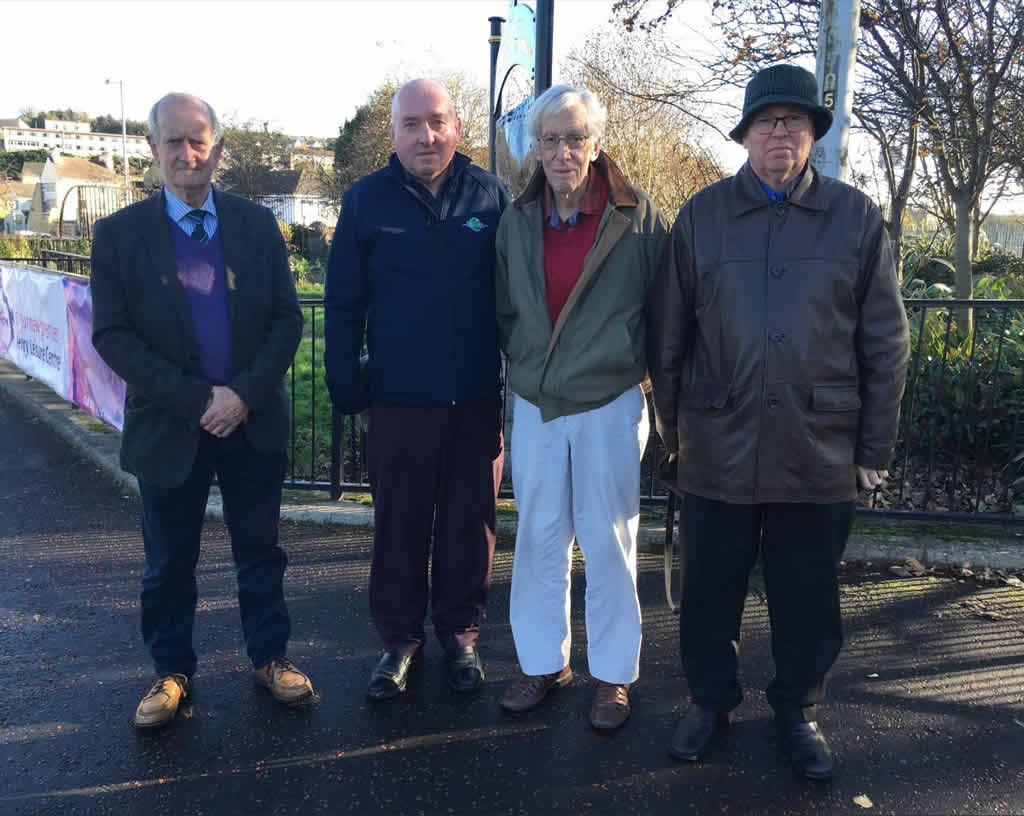
Gregg Bemis meeting members of the Newry Maritime Association
On the morning of 5th November 2016, we arrived to the site of the Lusitania Davit and to our amazement, the artefact that some weeks ago previously had been rusted and in a total state of dilapidation, had now been sand blasted, restored and repainted.
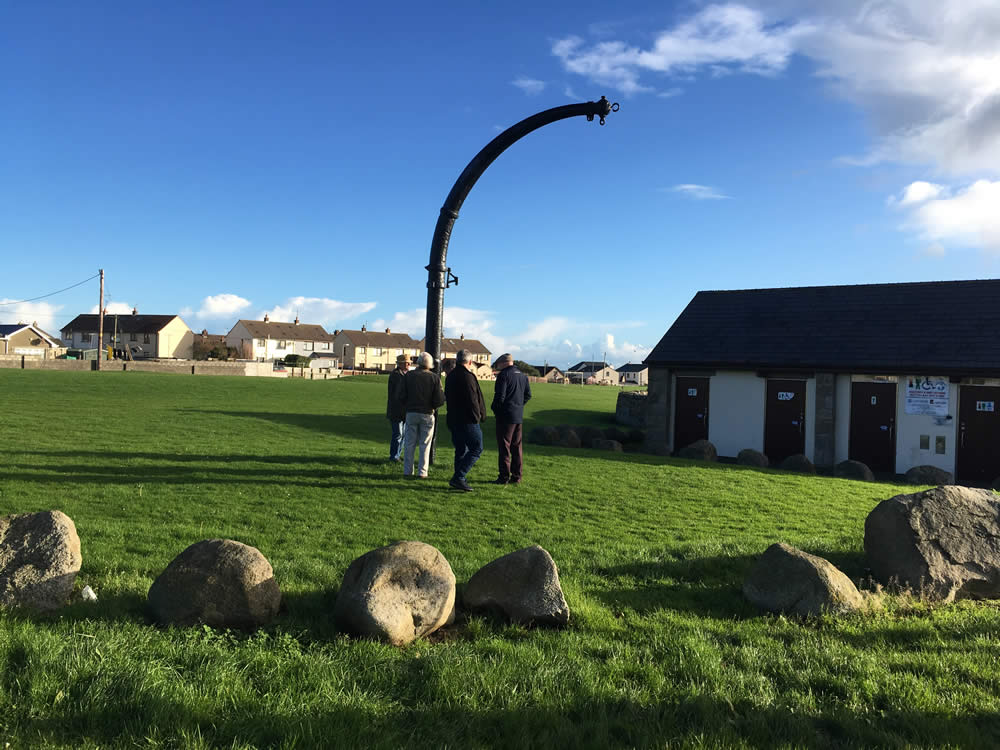
Inspecting the Davit in Annalong
It was now obvious that The Lusitania Davit was now of interest to someone apart from ourselves.
Gregg was impressed with the artefact but was only interested if it was possible if the Artefact could be relocated at the Lusitania Museum in Kinsale. Later that evening , Gregg was left to Dublin where he caught a train to Cork and set off see others on matters relating to the Lusitania
We and the Maritime Association now commenced speaking with local councilors, the most notable being Roisin Mulgrew the chairperson of Newry & Mourne council and her voice carried great weight. The Maritime Association also sought the help of a local councillor Sloan who represented the local people. After a period of negotiations it was soon recognized by the councillors, who represented both sides of a divided community that there was only one proper way forward and that being that the Lusitania Davit should go back to Kinsale where it would be regarded as the largest artefact of the Lusitania in Ireland. This project went to a subcommittee to discuss the project and agreement was reached. Now it had to go to the main committee for ratification.
It again was to the great credit of the council that everyone agreed and the matter was passed without objection.
On reflection, it was ironic that whilst all political parties agreed on the relocation of the Lusitania Ships Davit, to date, the political parties of Northern Ireland are unable to agree to govern from Stormont.
Now it was a matter of time and organization to get the Davit removed and transported to Kinsale!
For some weeks after the decision was given by Newry & Mourne Council that the Lusitania Davit, would be relocated to Kinsale. It was at this point that we realized that there was no date specified at the Council meeting of a date that the physical works would take place. At this time, like so many times before, Gerry Brown went off to Roisin Mulgrew, Chairperson of Newry & Mourne Council to see what could be done in relation to the physical extraction of the artefact. As like in so many times before, Roisin with assistance from other councilors, organized a date for the works to begin. Within one day, the Lusitania Davit was removed and transported to Newry. It was ironic that this deed was one of the very last functions that Roisin did prior to her term in office as leader of Newry & Mourne Council expiring.
On 4th June 2018, there was a ceremony at the Council Offices in Newry, which was attended by members of Newry & Mourne Council, The Doyle Family, Con & JJ Hayes from the Lusitania Museum, Gerry Brown & Peter McCamley.
Later that afternoon, an articulated vehicle arrived from Kinsale to collect the Lusitania Davit for its final voyage. The lorry was owned and driven by Pat Hayes, a brother of Con & JJ Hayes. Con Hayes is the Curator of The Lusitania Museum and JJ is the Chairman. These two individuals are amongst the founding members of The Lusitania Museum in Kinsale. https://www.oldheadofkinsale.com
Once loaded using three forklifts at strategic points, the Lusitania Davit, made its way over the border and on towards Kinsale.

The Davit getting loaded onto the lorry for the trip to Kinsale
On 24th Aug 2018, a special ceremony was organized at The Lusitania Museum at the old Head of Kinsale. It was attended by Gregg Bemis and his son Dave, local dignitaries plus a delegation from Newry & Mourne Council, which included Mark Murnin, the new Newry & Mourne Council Chairman, as well as Roisin Muldrew and the Lusitania Project 17 Dive Team.
Our journey had now come to a successful conclusion.
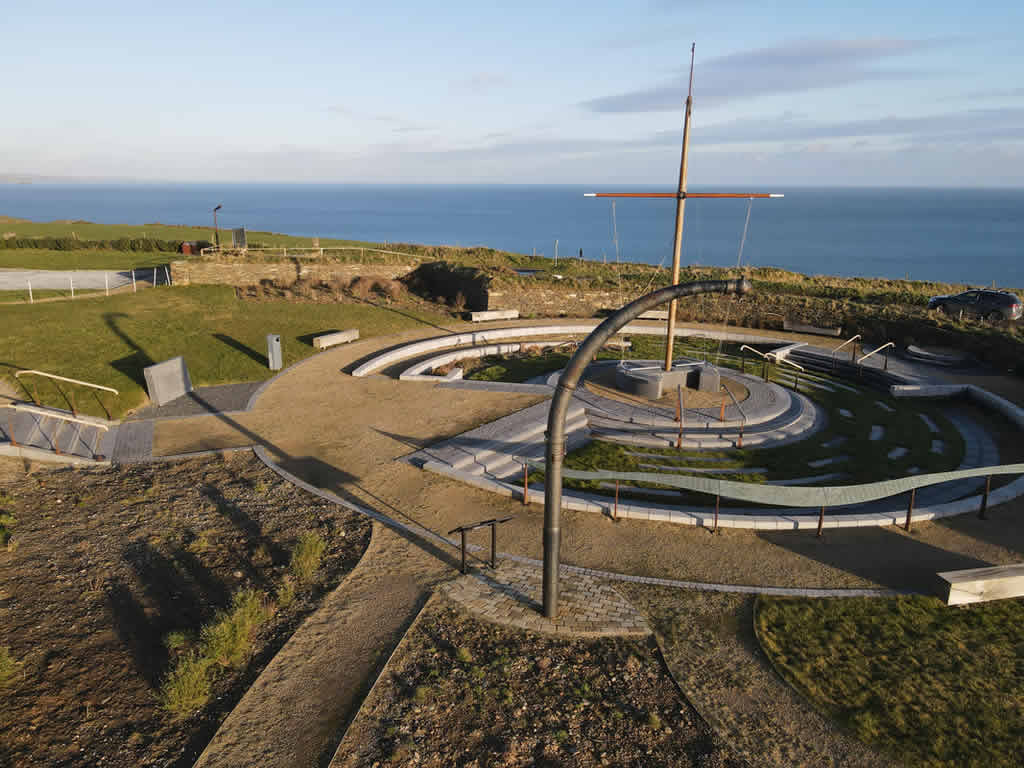
The Davit at The Old Head Museum Kinsale where it points towards the shipwreck.
Like so many things in life there is always something that has to be an incendiary for a project to commence. Having a project and then bringing it to a successful conclusion cannot be achieved by one individual. Only with the assistance, drive & passion from a great number of individuals can something like what was achieved with the Lusitania Davit.


